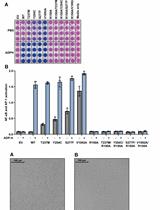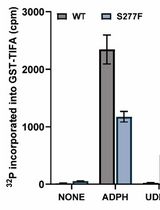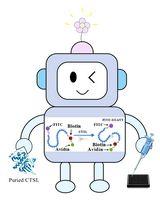- EN - English
- CN - 中文
An Automated pre-Dilution Setup for Von Willebrand Factor Activity Assays
血管性血友病因子活性检测的自动化预稀释系统
发布: 2024年09月05日第14卷第17期 DOI: 10.21769/BioProtoc.5059 浏览次数: 1213
评审: Anupama SinghNeha NandwaniNavnita DuttaAnonymous reviewer(s)
Abstract
Accurate quantification of von Willebrand factor ristocetin cofactor activity (VWF:RCo) is critical for the diagnosis and classification of von Willebrand disease, the most common hereditary and acquired bleeding disorder in humans. Moreover, it is important to accurately assess the function of von Willebrand factor (VWF) concentrates within the pharmaceutical industry to provide consistent and high-quality biopharmaceuticals. Although the performance of VWF:RCo assay has been improved by using coagulation analyzers, which are specialized devices for blood and blood plasma samples, scientists still report a high degree of intra- and inter-assay variation in clinical laboratories. Moreover, high, manual sample dilutions are required for VWF:RCo determination of VWF concentrates within the pharmaceutical industry, which are a major source for assay imprecision. For the first time, we present a precise and accurate method to determine VWF:RCo, where all critical pipetting and mixing steps are automated. A pre-dilution setup was established on CyBio FeliX (Analytik-Jena) liquid handling system, and an adapted VWF:RCo method on BCS-XP analyzer (Siemens) is used. The automated pre-dilution method was executed on three different, most frequently used coagulation analyzers and compared to manual pre-dilutions performed by an experienced operator. Comparative sample testing revealed a similar assay precision (coefficient of variation = 5.9% automated, 3.1% manual pre-dilution) and no significant differences between the automated approach and manual dilutions of an expert in this method. While no outliers were generated with the automated procedure, the manual pre-dilution resulted in an error rate of 8.3%. Overall, this operator-independent protocol enables standardization and offers an efficient way of fully automating VWF activity assays, while maintaining the precision and accuracy of an expert analyst.
Key features
• Automated pre-dilution setup for von Willebrand factor concentrates of various natures.
• Combination of a liquid handling system (CyBio FeliX) with a coagulation analyzer (BCS-XP).
• Simplifies method transfer to other laboratories.
• Basic training for CyBio FeliX and BCS-XP is required.
Keywords: Automation (自动化)Graphical overview
 VWF:RCo assay principle and measurement setup. Platelets (yellow ellipsoids) with negative surface charge (- - -) are treated with formaldehyde, which partly denatures the cell surface and thus stabilizes platelets for use as assay reagents. Stabilized platelets (dark-yellow-framed yellow ellipsoids) are then brought in contact with ristocetin A (chemical structure shown; black dots), which binds to the platelet surface and facilitates binding of VWF (green circles). The graphs show an example of quantitative determination of platelet agglutination by measurement of light transmission, where increasing amounts of VWF increase light transmission over time. The photo in the left-bottom corner shows the CyBio FeliX setup for VWF sample dilution and the photo in the right-bottom corner displays the BCS-XP system, which is used for VWF:RCo measurements.
VWF:RCo assay principle and measurement setup. Platelets (yellow ellipsoids) with negative surface charge (- - -) are treated with formaldehyde, which partly denatures the cell surface and thus stabilizes platelets for use as assay reagents. Stabilized platelets (dark-yellow-framed yellow ellipsoids) are then brought in contact with ristocetin A (chemical structure shown; black dots), which binds to the platelet surface and facilitates binding of VWF (green circles). The graphs show an example of quantitative determination of platelet agglutination by measurement of light transmission, where increasing amounts of VWF increase light transmission over time. The photo in the left-bottom corner shows the CyBio FeliX setup for VWF sample dilution and the photo in the right-bottom corner displays the BCS-XP system, which is used for VWF:RCo measurements.
Background
Von Willebrand factor (VWF) is the largest soluble plasma protein in all species with a blood clotting system; it has essential functions in blood coagulation, control of bleeding, and angiogenesis [1,2]. Shear stress in the bloodstream plays a crucial role in the functional characteristics of VWF. While, for example, high shear rates are needed for the binding of VWF to GPIbα, the shear rate needs to be below a critical level for effective binding to coagulation factor VIII (Figure 1) [3]. VWF plays an important role in the pathology of various diseases, including bacterial infections and cardiovascular conditions [4,5]. Another example where VWF is highly involved is in diseases resulting from inherited or immune-mediated deficiencies of ADAMTS13, a metalloprotease that serves as the natural regulator of VWF size and function through specific proteolysis [6,7]. Furthermore, most recently, an association between a VWF/ADAMTS13 imbalance and the prolonged presence of highly thrombogenic ultra-high-molecular-weight (UHMW) VWF multimers was identified in patients with severe COVID-19 [8,9]. As a consequence, the VWF:RCo assay is now widely performed for research and the differential diagnosis of diseases in which VWF and ADAMTS13 are involved in pathological mechanisms and/or serve as valid biomarkers guiding therapies. Deficiencies or defects of VWF result in von Willebrand disease (VWD), the most frequent inherited bleeding disorder with a prevalence of 1 in 1000 individuals. VWD is a heterogeneous disease with different genetic subtypes called type 1, type 2 (with subtypes 2A, 2B, 2M, and 2N), and type 3 [10,11].
Besides genetic analysis, differential diagnosis of VWD requires the determination of VWF activity by different functional assays, of which the von Willebrand factor Ristocetin cofactor activity (VWF:RCo) assay is the most important. Ristocetin A is an antibiotic effective against Gram-positive bacteria and mycobacteria. Its use was discontinued due to its association with thrombocytopenia. However, this effect is utilized to, at least partially, mimic primary hemostasis in vitro by facilitating the binding of VWF to GPIbα, leading to platelet agglutination [12]. A recently published survey among expert laboratories revealed that the VWF:RCo assay is the most commonly established VWF assay worldwide [13]. It is needed for the diagnosis of all VWD subtypes except for type 2N. While the other subtypes are, in part, characterized by lower VWF:RCo levels, type 2N typically exhibits normal VWF:RCo. Instead, this subtype involves reduced binding to coagulation factor VIII [14]. The VWF:RCo assay is not only the standard functional assay for the diagnosis of VWD but is required for potency assignment to VWF concentrates within the pharmaceutical industry [15–17]. The European Pharmacopoeia defined this assay and international VWF standard samples to determine the VWF activity of VWF-containing drug products. The assigned activity is then used to specify the dosage of these biopharmaceuticals [18]. Besides its broad utilization, the assay requires technical expertise, is labor intensive, and has a high degree of inter- and intra-assay variation [15]. Recently issued international clinical guidelines call for further research improving the VWF:RCo assay, which “has greater variability, resulting in the potential for misdiagnosis and/or misclassification” [14].
The performance of the VWF activity assays has already been improved and simplified for operators by automation on dedicated coagulation analyzers [19,20]. These devices are commonly used worldwide to determine VWF activity [17,21–23]. In contrast to diagnostic plasma samples, plasma-derived VWF (e.g., Immunate® and Biostate®) and recombinant VWF (rVWF) products (Vonvendi® or Veyvondi®) are highly concentrated. To obtain the concentration range prescribed by the European Pharmacopoeia for the measurement of VWF:RCo, these biopharmaceuticals need to be diluted, which is mainly performed manually [18].
Here, we demonstrate an approach to determine the VWF:RCo of VWF concentrates, where all critical pipetting and mixing steps are automated. We have established a pre-dilution setup for VWF concentrates on a CyBio FeliX system (Analytik-Jena). This liquid handling system (LHS) is versatile, compact, and affordable, making it interesting not only for the pharmaceutical industry but also for academia. Despite its benchtop size of only 650 mm × 450 mm × 700 mm, it can be employed for a wide range of applications. For example, it is used for DNA purification, transformation of bacterial cells, and purification of Aβ peptides for the diagnosis of Alzheimer's disease [24–26]. The combination of the LHS and the adapted method on BCS-XP provides a precise and accurate determination of VWF activity in samples of various natures of VWF concentrates, and VWF-containing samples, without requiring specific training for the VWF:RCo assay. This ensures accurate diagnosis and potency assignment of VWF as a drug substance and drug product. Moreover, this approach offers an operator-independent method, which may also reduce errors compared to manual dilutions. With fewer errors, fewer measurements need to be repeated, resulting in reduced hands-on time for operators. Furthermore, fewer errors result in reduced reagent consumption, thereby increasing cost efficiency. In addition, implementation of the automated pre-dilution steps simplifies method transfer to other laboratories and lays the foundation for the full automation of various VWF assays.

Figure 1. Schematic domain structure of von Willebrand factor according to Lenting et al. [1]. Binding domains of coagulation factor (FVIII), platelet glycoprotein Ib alpha (GPIbα), and different collagens are shown.
Materials and reagents
Reagents
Distilled water
Imidazole + 1% albumin buffer (Baxter AG Vienna, catalog number: 1501390)
BC von Willebrand reagent (Siemens, catalog number: OUBD37)
Equipment
CyBio FeliX (Analytic-Jena, catalog number: OL5015-100-24)
BCS-XP (Siemens)
Adapter 24 tubes, passive cooling function (Analytik-Jena, catalog number: 844-00136-0)
Waste box (Analytik-Jena, catalog number: 844-00430-0)
TipRack 96/1,000 µL (Analytik-Jena, catalog number: OL3317-11-140)
CyBio Robo tip tray 96/1,000 µL (Analytik-Jena, catalog number: OL3810-25-871)
12-channel adapter (Analytik-Jena, catalog number: OL3316-14-340)
Support; 37 mm height (Analytik-Jena, catalog number: OL3317-11-120)
Axygen 8-row v-bottom high-profile reservoir (VWF, catalog number: 47743-966)
Protective cap (Analytik-Jena, catalog number: OL3316-11-200)
96-deep-well plate (VWR, catalog number: 736-0607)
5 mL glass flasks (Siemens, catalog number: 10873438)
Magnetic stirrer (Siemens, catalog number: 10642244)
Pipettes and tips
1.5 mL tubes
Software and datasets
CyBio FeliX script (shown in Supplementary information 1)
BCS-XP tests (shown in Supplementary information 2)
Microsoft Excel
Procedure
文章信息
稿件历史记录
提交日期: Mar 21, 2024
接收日期: Jul 22, 2024
在线发布日期: Aug 8, 2024
出版日期: Sep 5, 2024
版权信息
© 2024 The Author(s); This is an open access article under the CC BY-NC license (https://creativecommons.org/licenses/by-nc/4.0/).
如何引用
Schachinger, T., Holik, A. K., Schrenk, G., Gritsch, H., Hofbauer, S., Furtmüller, P. G. and Turecek, P. L. (2024). An Automated pre-Dilution Setup for Von Willebrand Factor Activity Assays. Bio-protocol 14(17): e5059. DOI: 10.21769/BioProtoc.5059.
分类
医学 > 心血管疾病
生物化学 > 蛋白质 > 活性
您对这篇实验方法有问题吗?
在此处发布您的问题,我们将邀请本文作者来回答。同时,我们会将您的问题发布到Bio-protocol Exchange,以便寻求社区成员的帮助。
提问指南
+ 问题描述
写下详细的问题描述,包括所有有助于他人回答您问题的信息(例如实验过程、条件和相关图像等)。
Share
Bluesky
X
Copy link











